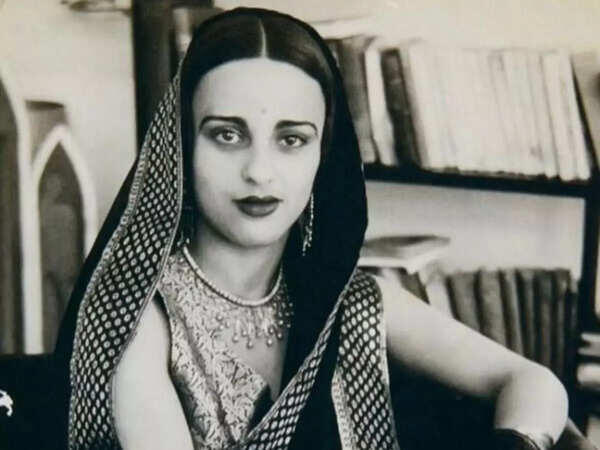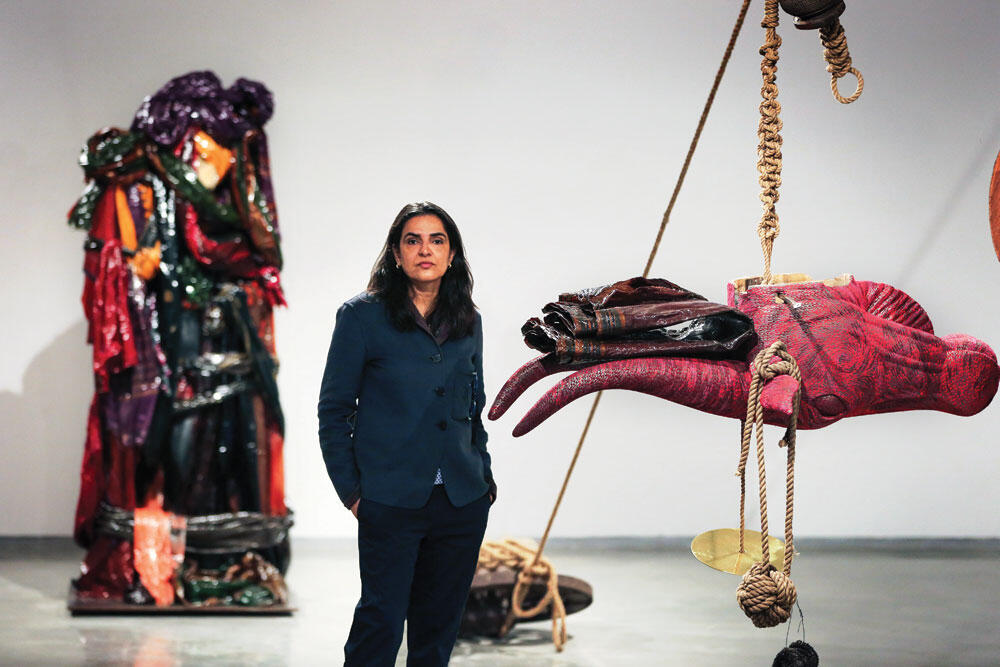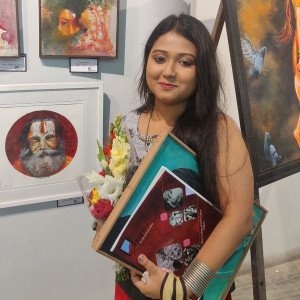In 2023, Indian women artists attained unprecedented recognition globally. Amrita Sher-Gil's 'The Story Teller' has become the most expensive Indian artwork ever sold, Google has recognized Zarina Hashmi for her lifetime achievements, and Nalini Malani has been awarded the 2023 Kyoto Prize, indicating a significant rise in prominence for Indian women artists in both modern and contemporary art. This year, modern Indian women artists maintained their creative influence, changing the art landscape and contributing to the growth of societal narratives. As 2024 approaches, the acknowledgment and interest in Indian women artists will undoubtedly increase.

Famous Indian Women Artists in History
Despite historical limitations on their social and cultural participation, many women in India pursued the arts, leaving behind legacies that continue to influence modern Indian culture and art. These women artists, from ancient times through the colonial era, and into the early modern period, have made important contributions to Indian art history.
Raja Ravi Varma’s Women Collaborators (Late 19th Century)
Raja Ravi Varma, often considered one of the greatest Indian painters of the colonial period, is widely celebrated for popularizing Indian mythological and religious imagery through his realistic paintings. However, it is important to note that Varma was aided by several talented women artists in his studio, although their names are largely lost to history.
While the women in Raja Ravi Varma's workshops remain anonymous, their contributions were essential to the growth of modern Indian art.
Women in his workshop were known to assist with the coloring, detailing, and decoration of his oleographs and lithographs. These women contributed significantly to Varma's pioneering work in art printing, helping to make his mythological depictions of Hindu deities and epic figures accessible to the masses.
Sunayani Devi (1875–1962)
Sunayani Devi, one of India’s earliest recognized women painters, was a self-taught artist who grew up in the influential Tagore family of Bengal. While her brothers, Abanindranath and Gaganendranath Tagore, are widely acknowledged as key figures in the Bengal School of Art, Sunayani Devi quietly developed her artistic style that was inspired by traditional Indian folk art and mythology.
Devi’s work often depicted scenes from Hindu epics like the Ramayana and Mahabharata, as well as portrayals of rural life. She used simple, fluid lines and a minimalistic palette, creating compositions that conveyed a deep spiritual and emotional resonance. Her work, while initially overshadowed by her brothers, has gained recognition in later years for its distinctive style and its early challenge to Western artistic norms in colonial India.

Binodini Dasi (1863–1941)
Although Binodini Dasi, popularly known as "Noti Binodini," was primarily known as a stage actress, she also contributed significantly to the visual arts. Born into a marginalized community in colonial Bengal, Dasi’s life was one of resilience and determination. She emerged as a leading figure in Bengali theatre in the late 19th century and was deeply involved in all aspects of theater production, including set and costume design.
Binodini Dasi’s autobiography, Amar Katha (My Story), is considered one of the earliest autobiographies written by an Indian woman. Though her contribution to the visual arts came through her innovative designs for stage performances, her work blurred the boundaries between visual arts and performing arts, adding a unique dimension to India's cultural landscape.
Binodini Das'i's life and career continue to inspire many artists and playwrights, and her innovative vision for stage aesthetics has earned her a place in India's broader art history.
Sarla Devi Chaudhurani (1872–1945)
Sarla Devi Chaudhurani was an artist, writer, and activist from Bengal, known for her intellectual contributions to the Indian independence movement as well as her engagement with the arts. A niece of Rabindranath Tagore, she played an important role in the cultural revival of Bengal during the early 20th century.
While Sarla Devi was primarily known as a musician and writer, she also contributed to the visual arts, promoting the idea of Swadeshi (self-reliance) through Indian art and craftsmanship. She was instrumental in fostering an appreciation for traditional Indian art forms, especially during the period of the Bengal Renaissance. Her advocacy for the revival of indigenous artistic traditions helped shape the cultural landscape of Bengal and India as a whole.
Devayani Krishna (1910–2000)
Devayani Krishna was an influential modernist painter and a key figure in the development of post-independence Indian art. Born in Punjab, she was one of the few women in her time to receive formal art training, studying at the Government College of Art in Lahore. She was a part of the influential Progressive Artists Group, which included renowned artists like M.F. Husain and S.H. Raza.
Krishna’s works, largely abstract and modernist, explored themes of spirituality and the human condition. Her bold use of color and form distinguished her from her contemporaries. She was also involved in art education and worked closely with her husband, fellow artist Krishen Khanna, in promoting modern Indian art.
Devayani Krishna’s contributions to Indian modernism have been somewhat overshadowed by her male counterparts, but her work remains an important part of the narrative of postcolonial Indian art.
Amrita Sher-Gil (1913–1941)
Though Amrita Sher-Gil’s career predates India's independence and the modern era, she is a key figure whose legacy continues to influence contemporary women artists in India. Often referred to as the "Indian Frida Kahlo," Sher-Gil is one of the foremost women painters who broke away from the Western tradition of art and sought inspiration from Indian rural life, customs, and traditions.
Sher-Gil's works often explore the inner world of women, their emotions, and their experiences. She is particularly known for her bold use of color and the way she captured the nuances of Indian life. Her paintings, such as Bride's Toilet and Three Girls, have a deeply melancholic and introspective quality, making her a trailblazer in expressing the emotional depths of Indian women in her time.
Sher-Gil's contribution to the Indian art scene is invaluable. She redefined Indian modernism and opened the doors for future generations of female artists to express their unique perspectives on Indian identity and womanhood.
Famous Women Artists in Contemporary India
While the nation's artistic legacy spans millennia, contemporary India has seen the rise of women artists who have made remarkable contributions to the field of visual arts. These artists have not only challenged traditional artistic norms but have also confronted societal expectations, offering critical reflections on gender, politics, identity, and culture. Through a range of mediums, from painting to sculpture, installation, and video art, these women have become pioneers in India's evolving art scene.
Nalini Malani
Nalini Malani is a pioneering figure in the contemporary art world, renowned for her inventive application of technology and unique visual language, creating a significant influence on a global scale as a painter and multimedia artist. Born in Karachi in 1946, she attended Sir J.J. School of Arts and emerged as a pioneer of video art in India. Malani's oeuvre frequently examines themes of feminism, conflict, and the human experience, prompting audiences to confront intricate concerns in innovative and stimulating manners. Her commitment to perceiving the artist as an activist and her examination of women via several mediums have profoundly influenced contemporary art in India.
Bharti Kher
Prominent Indian artist Bharti Kher was born in London to Indian immigrant parents in 1969. She enthralls with her avant-garde compositions that surpass conventional limits and is renowned for masterpieces composed of several bindis. Kher is recognized for her intellectually stimulating sculptures and installations, frequently examining identity, mythology, and femininity issues. Employing an own artistic lexicon, she contests traditional concepts, utilizing unexpected materials to create narratives that appeal universally. She persistently expands the limits of creative expression and engages in a vibrant dialogue concerning culture, gender, and the transformation of modern art in India and beyond. The artist presently resides and operates from New Delhi.
Shilpa Gupta
Shilpa Gupta, born in Mumbai in 1976, is recognized for her conceptual and socially involved work. She obtained her Bachelor of Fine Arts in Sculpture from Sir J. J. School of Art in 1997. By employing text, ephemera, sound, and light, she produces works that examine the subjectivity of reality by disrupting conventional media roles. In 2023, Gupta's installations and interactive artworks have ignited discussions around identity, boundaries, and political reality. Her art surpasses traditional limits, encouraging spectators to engage in discourse and contemplate the interrelation of global challenges.
Rekha Rodwittiya
Renowned for her striking paintings that explore feminist and socio-political themes, Rodwittiya has positioned herself as a formidable creative force. Born in 1958 in Bangalore, her oeuvre is distinguished by vivid colors, complex details, and a unique style that amalgamates traditional and contemporary elements. Rodwittiya's artwork frequently examines the intricacies of female identity, contesting stereotypes and promoting women's empowerment. Her canvases are profound representations of the complex lives of women in society. Rodwittiya's oeuvre showcases vibrant, striking hues alongside feminine characters and motifs, forming a fascinating tapestry. She presently resides and is employed in Baroda.
Anjolie Ela Menon
Anjolie Ela Menon is one of India’s most celebrated modern painters. Although she belongs to the contemporary period, her influence and recognition have spanned multiple decades, making her a significant figure in the history of Indian art. Known for her distinctive style, which blends realism with surrealism, Menon often focuses on themes of womanhood, domesticity, and personal memory.
Her early works were inspired by Byzantine iconography, with muted colors and haunting, introspective figures. Over the years, Menon has explored a range of subjects, from nudes and portraits to depictions of rural life. Her ability to evoke emotion and her mastery of oil painting have made her one of the most influential women in Indian art history.
Anita Dube
Anita Dube is an influential voice in contemporary Indian art, known for her conceptual and activist approach. Initially trained as an art historian and critic, Dube transitioned into the visual arts in the late 1980s. Her work engages with themes of feminism, sexuality, and memory, often incorporating found objects, photography, and sculptural installations.

Dube's work often challenges established norms and hierarchies within society and art. One of her most renowned works, Silence (Blood Wedding) (1997), uses prosthetic eyes, fabric, and other found objects to explore ideas of surveillance, repression, and the female body. Her use of unconventional materials highlights her innovative approach to the craft, as she seeks to dismantle traditional notions of beauty and representation in art.
A committed feminist, Dube has also been an active organizer within the Indian art world. In 2018, she became the first woman to curate the prestigious Kochi-Muziris Biennale, where she invited artists from across the globe to explore themes of resistance and empowerment. Through her work and activism, Dube continues to push the boundaries of contemporary Indian art, creating space for marginalized voices and challenging dominant cultural paradigms.
Women Artists of India: An Inspiration
The history of women artists in India is both rich and diverse, though many of their contributions have remained underappreciated for decades. From the traditional artisans and painters of earlier centuries to the more formally recognized modernists and contemporary figures, Indian women have made substantial contributions to the visual arts, often under challenging circumstances.
Their stories, whether of quiet perseverance or bold defiance, reflect the broader struggles of women in Indian society, as well as their determination to shape and influence the artistic heritage of their country. Today, as their works are rediscovered and celebrated, these women artists are finally receiving the recognition they deserve for their vital role in shaping Indian art history.
In celebrating the contributions of famous Indian female artists, we honor their trailblazing spirit, creativity, and cultural impact. Their diverse works, ranging from traditional to contemporary art, have enriched India’s artistic heritage, inspiring future generations and expanding the global appreciation for Indian art and its powerful female voices.















